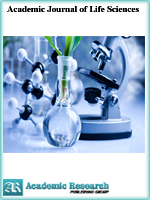Academic Journal of Life Sciences
Online ISSN: 2415-2137
Print ISSN: 2415-5217
Print ISSN: 2415-5217
Quarterly Published (4 Issues Per Year)

Archives
Volume 8 Number 3 December 2022
Antibacterial Activities of Medicated and Antiseptic Soaps on Staphylococcus Aureus and Pseudomonas Aeruginosa Isolated from Wound Infection
Authors: Nwankwo I. U. ; Edwards K. C. ; Itaman V. O. et.al.
Pages: 39-45
DOI: doi.org/10.32861/ajls.83.39.45
Abstract
Soaps and other cleaning chemicals have been widely utilized for various cleaning purposes for a long time. As the skin is the first line of defense, most bacteria like Pseudomonas aureginosa and Staphylococcus aureus reside and are the primary cause of skin infections.The aim of this study was to determine the antibacterial effects of medicated soap (tetmosol) and antiseptic soap (premier cool) against Staphylococcus aureus and Pseudomonas aeruginosa isolated from wound samples. The antibacterial activity of medicated and antiseptic soapswas investigated against test organisms (Staphylococcus aureus and Pseudomonas aeruginosa) using agar well and disk diffusion methods. After serial dilution, different concentrations of the various soap samples in the range of 200 mg/ml to 62.5 mg/ml were prepared (using sterile distilled water). The result of this study showed that the antiseptic soap “Premier cool” was found to be most effective against all the bacteria strains tested. The antiseptic soap had the highest zone of inhibition (19.00 ± 1.42 mm) against Staphylococcus aureus and 15.00 ± 0.34 mm against Pseudomonas aeruginosa at the highest dilution used (200mg/ml). The medicated soap “Tetmosol” exhibited a minimal antibacterial activity against the isolates with a zone of inhibitions of 16.00 ± 0.48 mm 14.00 ± 1.41 mm for Staphylococcus aureus and Pseudomonas aeruginosa, respectively. The result of the minimum inhibitory concentration showed that antiseptic soap (Premier cool) had better MIC and MBC of 12.5 mg/ml and 25 mg/ml, respectively, on Staphylococcus aureus. For Pseudomonas aeruginosa, the MIC and MBC were 50 mg/ml, respectively. Medicated soap (Tetmosol) had a higher MIC of 25 mg/ml and MBC of 50 mg/ml for Staphylococcus aureus. For Pseudomonas aeruginosa, the MIC and MBC were 50 mg/ml and 100 mg/ml. The present work has shown that Staphylococcus aureusand Pseudomonas aeruginosa were susceptible to assayed medicated (Tetmosol) and antiseptic (Premier cool) soaps. This study proved that all the soaps samples had antibacterial activity against all the tested bacterial strains. Still, Premier cool soap is the most effective soap against all the given bacteria and should be the first choice for daily use. It is recommended that further studies should be done on antimicrobial resistance, both phenotypic and genotypic, concerning prolonged use of medicated and antiseptic soaps.
Comparison of the Nutrient Compositions in Red and Green Amaranthus (Amaranthus hypochondriacus)
Authors: Md. Maksudul Haque ; Md. Shariful Islam ; Elora Parvin, et. al.
Pages: 33-38
DOI: doi.org/10.32861/ajls.83.33.39
Abstract
Amaranth has two morphological types, one is red and another is green. For this study, we collected five red and five green morph samples to analysis in terms of proximate, minerals, antioxidant pigments and phytochemicals and antioxidant activity in three replicates. The leaves of red amaranth are an outstanding source of dietary fiber, carbohydrates, moisture, and protein. We found remarkable potassium (6.55 mg/g), calcium (2.63 mg/g), magnesium (3.01 mg/g), iron (10.94 µg/g), manganese (13.16 µg/g), copper (2.01 µg/g), zinc (11.57 µg/g), carotenoids (47.13 mg/100g), total phenolics (14.36 GAEµg/g), vitamin C (50.74 mg/100g) and antioxidant activity (ABTS+) (25.27 TEACµg/g) in the red amaranth leaves. These data indicated that red and green could be considered as enriched in their antioxidant profiles. Carotenoids exhibited significant positive associations with TPC, TFC and TAC (ABTS+). Vitamin C had a minor and positive interrelationship with TAC, TFC, and TPC, although it exhibited negative and insignificant associations with carotenoids. TPC, TFC and TAC (ABTS+) showed a significant positive association. Red amaranth is an excellent source of nutrients, antioxidant pigments, minerals, and phytochemicals compared to green amaranth. In this investigation, it was revealed that flavonoids, phenolic compounds and carotenoids had strong antioxidant activity and significantly contributed to the antioxidant activity of the green and red of amaranth. Red amaranth could be a potential source of nutritional components and antioxidant phytochemicals in the human diet providing opportunities to address mineral nutrient deficiencies and provide an antioxidant rich food.



